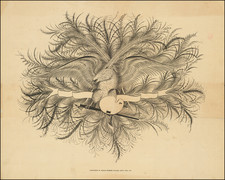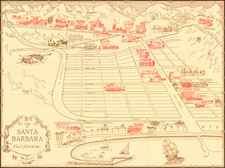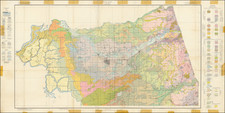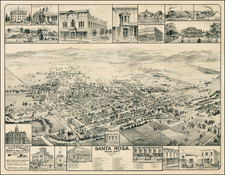Showing How Wong's Seaweed Farm!
Interesting map of Cambria, Cambria Pines and Cambria Pines Estates, published by Ray Shamel and Gay Shamel, local Cambria Realtors.
At the time, the road through the region (Highway 1) was still just a "Proposed State Highway". The map shows the schools, a Veterans Building, Coast Union High School, several Churches, the Cambria Lodge, Ocean Pines YMCA, Camp Pinecrest and the Wong Kelp Farm.
Ray Shamel (1894-1978) was apparently a prominent Realtor. The county park that was renamed Shamel Park in the early 1970s.
How Wong Kelp Farm
The Wong Kelp Farm was owned at the time by How Wong (or Wong How) (1895-1975). Wong was the last of the seaweed gatherers in the region. His cabin was located 2 miles north of Cayucos at the mouth of Villa Creek. Unlike most of the other gatherers, he owned the cabin and surrounding land, which he had inherited from his uncle, who in the 1860s came to the coast as a squatter and exercised his squatter's right.
Wong How and his family lived at an isolated location on the central Californian Coast from 1910 to 1975. Usually such close biographical investigation is the province of family history research, but because of its remoteness and late period of occupation, the Wong How site is highly intact, providing a relatively unique opportunity for an archaeology of household and family. The value of such an investigation lies in its construction of a fine-grained account of immigrant experience that reveals the complexity and nuances of identity and behaviour. This approach has particular value in the study of the Overseas Chinese, a people who have frequently been treated as a homogenous group rather than a complex set of diverse individuals.
It must be acknowledged, however, that the intactness and historical connectedness of Wong How's site is a rarity . . .
Cambria
Cambria is located on the Rancho Santa Rosa Mexican land grant given in 1841 to Julian Estrada.
Settlers were drawn to the area because of the fertile land, streams, and lumber. Later, miners came to the area with the 1862 discovery of cinnabar, an ore from which mercury can be extracted. For a while, Cambria was a boom town, with $280,000 worth of mercury shipped out of San Simeon between 1867 and 1870.
During several years Cambria was a booming mine town, and prospectors flooded the area. More than 150 claims were filed in the early 1870s. The most successful of these claims, the Oceanic Quicksilver Mining Company, at one time employed 300 and was the largest mine in the area and the sixth largest in the world. Three furnaces were built, seven tunnels completed, and their stock price jumped to $30.00 per share. Hopes were high, and Cambria residents dreamed of imminent wealth. Unfortunately, by 1878, mercury prices started to fall and Cambria's first economic boom ended, followed by a second boom. A devastating fire in 1889 virtually ended the mercury business and Cambria settled into a quiet dairy community.
Originally an American settlement called Slab Town, the town later known as Cambria was centered at the Leffingwell Cove of today's northern Moonstone Beach, which beach also featured a wharf. Because lumber production, ranching activities and mercury mining increased in the area, the village adopted the more dignified name of Cambria. The name as such was contributed by a local surveyor from Cambria County, Pennsylvania, because the local topography and flora reminded him of that place.
Cambria has benefited greatly from the building of Hearst Castle. During the high unemployment years of the Great Depression, many Cambria citizens found welcome employment in construction. Additionally, Cambria provided supplies, services, and accommodations for many who came to build the Castle, creating prosperity in Cambria in an otherwise less prosperous decade.










![[ Downtown St. Helena ] Mattioli's in your Pocket Guide St. Helena -- 13th Annual Edition [ Napa Valley, CA ]](https://storage.googleapis.com/raremaps/img/small/102768.jpg)



